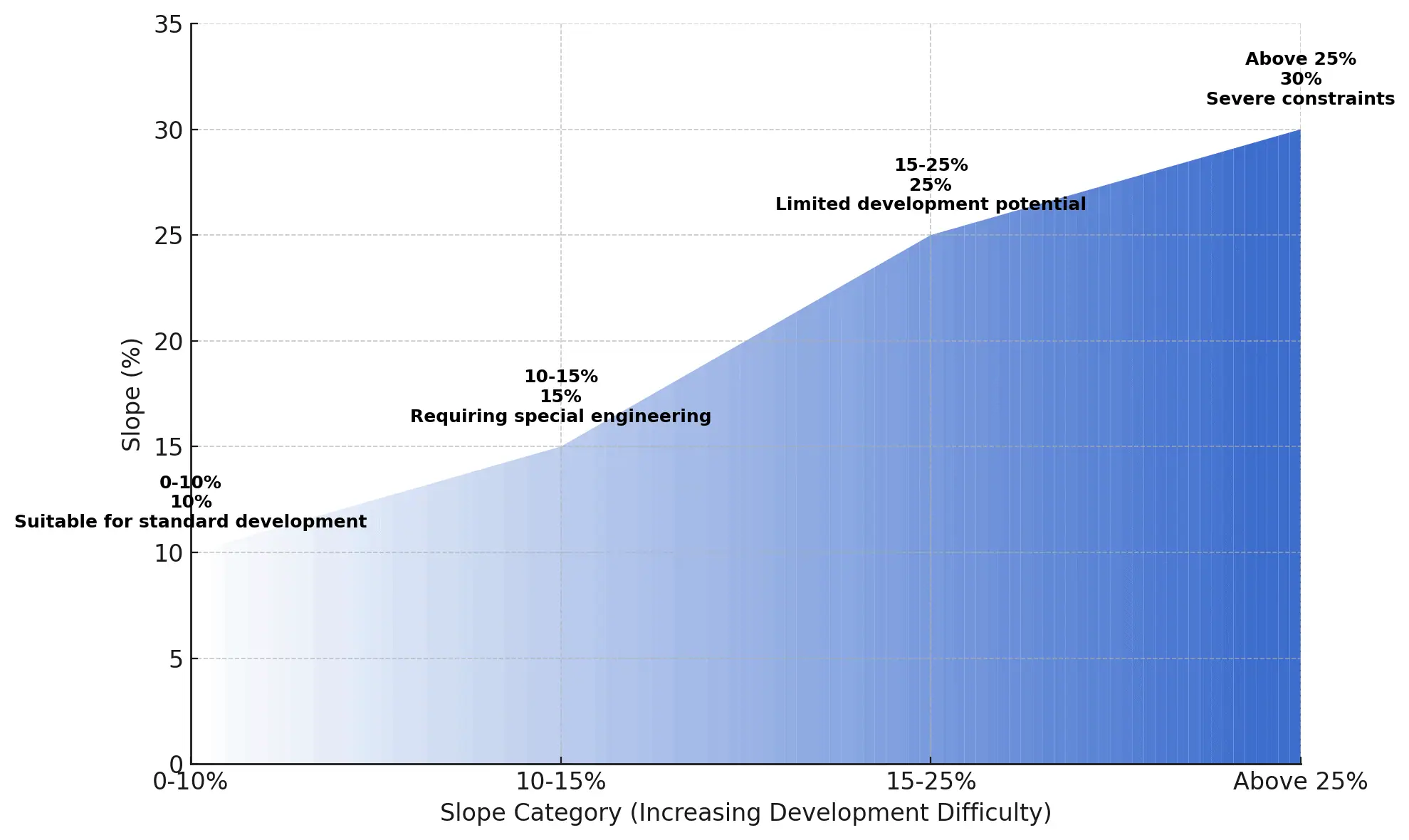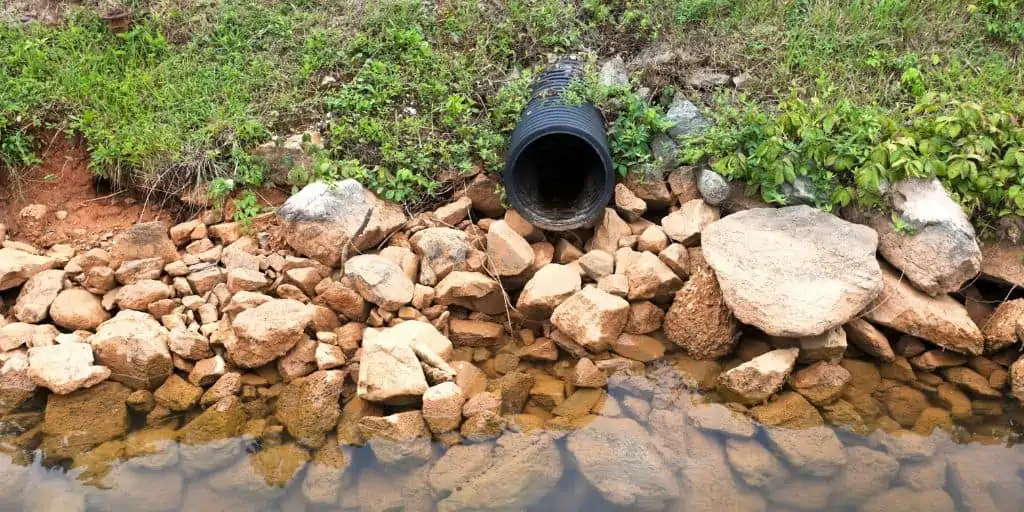What Is Topography?
Shortcuts
- Topography shows how land rises, falls, and changes shape—features that affect how much a property is worth and how it can be developed.
- Modern topographic mapping combines GPS, LiDAR, and drone technology to create detailed terrain analysis.
- Land features impact construction costs, development potential, and long-term maintenance expenses.
- Topographic surveys are required for most building permits and site plan approvals.
- Surface characteristics affect property value through views, buildable area, and natural hazard risk.
Understanding Topography
In general, topography is a description of the physical features, whether natural or artificial, of a certain area of land.
Understanding topography is a fundamental aspect of real estate because these physical characteristics impact almost everything when developing it for human use. For example, topography dictates what kind of buildings we can build on it, how much they cost, how water drains, and whether we get good views, among other things. Even the stability of a building and its long-term maintenance depend on the land it sits on.
Before computers and satellites, people used simple tools and mathematical measurements to create maps of the land. The military especially needed these maps to understand battlefields and plan operations. Over time, these mapping techniques became valuable for many other uses, especially in real estate development and planning. The precision and accuracy of these maps have increased dramatically as well.
For a real estate developer and investor, topography is a defining factor when choosing land for income-generating purposes. For example, building on a slope costs more for the foundation than building on flat ground, since the foundation must be deeper on the downhill side to reach stable soil and may need extra reinforcement to prevent sliding. Therefore, if the slope gets steeper, you might not be able to build at all because of local rules or simply because it’s physically impossible to do so.
We discuss this further in our blog post, “Slope Savvy: Navigating the Ups and Downs of Hillside Construction.”
Modern Topographic Analysis
Today’s land surveyors use several tools to map land accurately. They use GPS devices that can measure within a centimeter, laser scanners that take a million measurements per second, and drones that take detailed pictures from above.
These tools create maps that show:
- Elevation, or how high or low different parts of the land are.
- Natural things like streams and rock outcrops.
- Man-made features like buildings and utility lines.
- What kind of soil is present.
- Drainage patterns, or where water flows when it rains.
Understanding Contour Lines and Slope Analysis
Topographic maps use contour lines to show height changes. Think of these lines like steps; each line shows places at the same height. Usually, the space between lines represents a height difference, so the closer the lines are, the steeper the elevation, and vice versa.
To calculate the slope percentage (or the elevation of a certain piece of land relative to flat land), divide the vertical change (rise) by the horizontal distance (run) and multiply by 100:
Slope % = (Rise/Run) x 100
Using this example, contour lines that show land rising 10 feet up (vertical) over a horizontal distance of 100 feet, the calculation would be:
(10 ÷ 100) × 100 = 10% slope
Think of it like this: for every 100 feet you walk forward on this land, you climb up 10 feet in height. This means a 10% slope—steep enough to require careful planning but still suitable for standard development.
Slope percentages are particularly important for planning and zoning departments in many jurisdictions because they use them as the basis for potential development. A general framework is represented by the graph below:
Topography in Real Estate
Land shape creates both good and bad effects for real estate development. For example, in places like Colorado, properties on hills might sell for 30-40% more because of their views. However, they might also cost 50-100% more to develop.
Here are topographic considerations in real estate:
Development Costs and Site Preparation
The cost of preparing land for building depends on its slope. Flat land (0-5% slope) costs $1.25 to $2 per square foot to prepare. As the slope increases, so do costs.
These higher costs come from five main things. You need to move dirt around to make the site level; walls to hold back soil on slopes; special foundations for sloped land; drainage systems to control water; and, finally, engineers to make sure everything is safe and stable.
Impact on Property Values
Topography also influences how much attractive it is to buyers. The more appealing it is, the higher price it can fetch in the market.
Research indicates that topographical features like slope and elevation can significantly influence property values. Homes with elevated positions often offer superior views, leading to price premiums. Additionally, natural slopes that provide privacy or unique lot shapes allowing for additional structures can enhance a property’s desirability and market value.
Note that this isn’t always a 100% guarantee. Property values are more nuanced than “slope = higher price,” so it’s a good idea to check your market first.
Risk Assessment and Mitigation
Insurance companies look at two main risks related to topography.
First, they check flood risk for properties in low areas or at the bottom of slopes. The Federal Emergency Management Agency (FEMA) makes maps that show flood zones and set rules for building and insurance. If you want to find out yourself if your property is in a flood zone, watch this video:
Second, they check landslide risk by looking at five things:
- Steepness of the slope
- Soil composition
- How much water is in the ground
- Landslide history (if any)
- Plant species in the vicinity
Legal and Regulatory Topographic Considerations
Most cities and counties have building rules based around topographic considerations.
For example, if you have steep slopes, you need extra erosion control. Similarly, if you have significant height changes, you might need to protect views or watersheds.
Here’s an in-depth explanation of each area of focus:
Building Code Limits
Modern building codes set clear limits for different site elements:
- Driveways can’t be steeper than 15%
- Building sites must be under 10% slope for erosion control and drainage
- Cut slopes must be no steeper than 2:1
- Fill slopes must be no steeper than 3:1
These requirements reflect years of engineering studies and practical experience in construction safety.
Drainage Regulations
Water control is one of the most important parts of developing land. Building codes have strict rules about how water should flow around buildings.
For example, the ground must slope away from your foundation at a minimum of 2%. Based on the slope calculation above, this means the land drops 2 feet for every 100 feet of distance. This land is slanted just enough that regular folks won’t notice, but still ensures water flows away from your building (instead of toward it).
Depending on how much it rains in your area and what your land looks like, you might also need special systems to store water or slow it down. Some properties need a retention system to collect water, while others need channels to direct it. You also need ways to limit soil erosion when it rains, using methods that fit your specific piece of land.
Setbacks and Environmental Protection
On steep slopes, you need to build farther back from your neighbor’s property than you would on flat land. This extra space is called a setback.
For example, the International Building Code (IBC) specifies that for slopes steeper than 1 vertical to 3 horizontal (approximately 33.3%), buildings must be set back a distance equal to one-third the height of the slope, but not exceeding 40 feet. This prevents problems like soil erosion crossing property lines or your building casting too much shadow on neighboring lots.
For example, if you’re building near the top of a hill or ridge, you might need to set your building even farther back. This helps preserve views for other properties and protects the natural look of the hillside.
This principle also applies to properties near bodies of water. Certain states have special setback requirements for properties near perennial or semi-perennial bodies of water, such as in the county of Sonoma in California.
Finally, some areas, like wildlife habitats or places with rare plants, have special protection zones where you can’t build at all.
Topographic Tools Used in Real Estate
Real estate professionals rely on several tools to understand a piece of land before buying or developing it. Making a mistake about land shape can cost hundreds of thousands of dollars in unexpected construction costs or lead to drainage problems.
Here are a few examples of modern tools that real estate professionals use to understand topography.
Free Digital Tools
Most professionals start with Google Earth because it’s free and easy to use. This program lets you measure basic slopes and elevations, and you can even create rough construction plans, among other things.
One of its most valuable features is the timeline tool—you can see if the property has had landslides, flooding, or major changes over the past 20-30 years. Real estate agents often use this tool first to spot potential problems before bringing in more expensive equipment.
Find out what else you can do with Google Earth as a real estate professional in our guide, “10 Google Earth Hacks Every Real Estate Professional Should Know.”
Smartphone Tools
Your phone can now do some amazing things with land measurement. Apps like SitePAD and Theodolite work like digital levels. When you visit a property, these apps can tell you how steep the land is and help you take basic measurements. You can save pictures with location information attached, which helps when showing properties to clients or planning where to build.
Many agents use these apps during property showings to answer client questions on the spot about whether they can build on a specific part of the land or how much site work might cost.
Professional Survey Equipment
For more detailed information, professionals use tools like total stations. These look like cameras on tripods but actually measure angles and distances within an eighth of an inch over 1,000 feet. They also use laser levels that shoot beams across the property to measure height differences.
While this equipment is expensive, it prevents costly mistakes. For example, discovering that part of a property has a hidden 20% slope could save a developer thousands in unexpected foundation costs.
Drones and 3D Mapping
Drone surveys have revolutionized how we look at land. A drone can fly over a property and take hundreds of pictures. Special software then turns these pictures into a 3D map so detailed it shows elevation changes as small as 2 inches.
Drone technology has reduced something that used to take days with traditional surveying to mere hours, even minutes. While drone surveys aren’t cheap, they often save money by finding problems early.
If you’re an agent or an investor who wants to sell land, you can show clients exactly what they can do with a piece of land, making the difference between making a sale or not. Savvy investors can showcase drone photos to interested buyers and increase the chances of scoring a sale.
FAQs: Topography
How does topography affect septic system requirements?
Septic system design hinges on a property’s topographic conditions. Health departments have strict rules to keep things safe and working well. The land needs a gentle slope (at least 2%) so waste flows properly, but it can’t be too steep (no more than 20%), or the system might fail.
You also need at least 3-4 feet of good soil above bedrock to preserve groundwater quality. More complex parcels might need more specialized (and thus more expensive) solutions.
One way to find out if the property, whether it’s in flat or elevated terrain, can handle septic system requirements is by running a perc test. We explain what it is in the video below.
What role does topography play in zoning variances?
Topographic hardship often justifies zoning variances. Local boards consider:
- Natural grade constraints
- Unique physical conditions
- Development limitations
Many jurisdictions grant height or setback variances when standard requirements would make reasonable use impossible due to topographic conditions.
How does topography influence flood insurance premiums and requirements?
Topographic position shapes flood insurance costs through elevation data and risk assessment. FEMA’s base flood elevation (BFE) measurements directly impact premiums: properties below base level face 4-5 times higher rates, while each foot above reduces costs by 15-30%.
Even properties outside FEMA flood zones might need coverage based on their topographic position in low-lying areas.
References
- REI Co-Op, “How to Read a Topo Map.” https://www.rei.com/learn/expert-advice/topo-maps-how-to-use.html
- United States Geological Survey, “To Determine Percent of Slope and Angle of Slope.” https://www.usgs.gov/educational-resources/determine-percent-slope-and-angle-slope
- HUD Exchage, “Environmental Assessment Factors and Categories eGuide.” https://www.hudexchange.info/programs/environmental-review/environmental-assessment/guide/land-development/slope/
- Diggs Custom Homes, “Buying Land and Building on a Hillside or Critical Area, Yes or No?“ https://customdiggs.com/buying-land-and-building-on-a-hillside-yes-no/
- KompareIt, “Cost of Site Preparation and Land Clearing.” https://www.kompareit.com/homeandgarden/developers-engineers-land-prep.html
- MDPI, “More Reliable Land Price Index: Is There a Slope Effect?” https://www.mdpi.com/2073-445X/10/3/261
- Angi, “What Is the Maximum Driveway Slope (or Grade)?” https://www.angi.com/articles/maximum-driveway-slope.htm
- BuildingAdvisor, “EVALUATING SLOPE, SOILS, DRAINAGE & RADON.” https://buildingadvisor.com/buying-land/site-characteristics/slope-soils-water-vegetation/
- International Code Council, “Chapter 33: Safeguards During Construction.” https://codes.iccsafe.org/content/IBC2018/chapter-33-safeguards-during-construction
- Office of Energy Efficiency and Renewable Energy, “Final Grade Slopes Away from Foundation.” https://basc.pnnl.gov/resource-guides/final-grade-slopes-away-foundation
- Department of Public Works – Los Angeles County, “FOUNDATION/BUILDING SETBACKS TO SLOPES.” https://dpw.lacounty.gov/bsd/lib/fp/Drainage%20and%20Grading/General%20Grading%20Documents/Building%20Setbacks.pdf
- Sonoma County, “DRN-005 Waterway Setback Requirements.” https://permitsonoma.org/instructionsandforms/drn-005waterwaysetbackrequirements
- Minnesota Stormwater Manual, “Design criteria for dry swale (grass swale).” https://stormwater.pca.state.mn.us/index.php?title=Design_criteria_for_dry_swale_%28grass_swale%29
- Federal Emergency Management Agency, “Appendix J: Rate Tables.” https://www.fema.gov/sites/default/files/documents/fema_fim-appendix-j-rate-tables_apr2021.pdf








